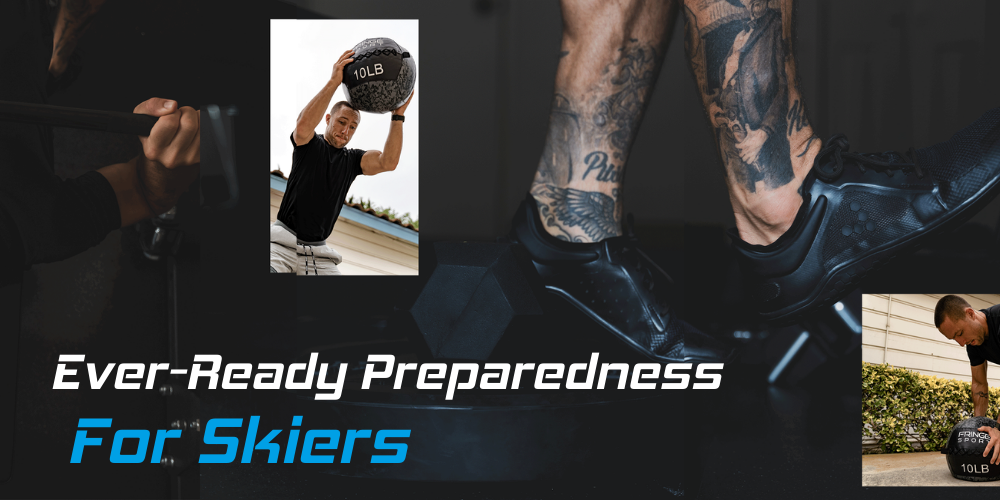
3 Steps To Become Ready For Anything
What does it mean to be “ever-ready”? How can we cultivate a lifestyle that leaves us prepared to handle any adventure? I am a firm believer that strength and conditioning lay at the core of this question. By prioritizing weekly movement, baseline cardiovascular training, and smart strength programming, you can establish a new floor for physical performance. In doing so, you will be ready when you get the call to join your fellow skiers on any adventure. From hiking back bowls, to cruising endless groomers, these three steps will help you become ever-ready.
As I break down these three steps, keep in mind that anything can be scaled up or down based on current output, limitations, and proficiencies. Think of this as a blueprint for the house. Once you start digging into the foundation, things change and you must adjust on the fly. But the plans are the plans, and they should always be referenced for guidance.
—
1. Establish Weekly Movement Frequency
One of the leading causes of most early onset chronic diseases is living a sedentary lifestyle which is classified as less than 150 minutes of movement per week. This can be tackled in a lump sum effort wherein you increase your daily and weekly movement baseline to 150 minutes or greater. Most commonly this is accomplished through tracking a simple target such as walking output. The 10,000 daily step count is typically referenced as an easy place to start. But what about us skiers? What do we do to establish weekly movement parameters while keeping skiing front and center?
This is where I recommend a 2x/week training frequency. This will allow you time to strength train at a frequency that can promote muscle development and strength improvements while also allowing for between two and three days of skiing. This weekly movement goal of 2x/week strength training will keep your body ready for anything. If someone asks you to join them for a day on the slopes, you’ll be ready to go. Anything less than 2x/week begins to battle efficiency between your training window and your ski volume.
2. Develop A Baseline Cardiovascular Engine
It doesn’t take much to establish a cardiovascular baseline, but you will definitely feel it’s absence. Ever get halfway down a run and feel like your heart is beating out of your chest, respiration is through the roof, and your legs are on fire? Most likely, this is the result of poor conditioning and lack of a cardiovascular engine to supply oxygen to your muscles while buffering carbon dioxide form your body.
To establish a baseline, or improve your current conditioning, aim for a single day of dedicated off-snow cardiovascular training. This can be a stationary bike, run, or even an elliptical. Aim for a 5 minute warm up, 25-30 cardiovascular bout wherein you maintain a moderate to low heart rate for the entire duration (think 5/10 difficulty). Maintaining this brief but effective cardiovascular training day, coupled with your Ski System training program, will produce an elevated level of conditioning and capabilities which will surely be realized on the ski hill.
3. Train Smarter, Not Harder
Once you’ve established the above habits, it is time to focus on rest as a discipline. Over-training is a real thing and it takes time to understand when you are at your body’s limit. A failure to rest and recover will produce lackluster performance on the hill, limitations in the weight room, and inadequate recovery periods for muscle repair and strength gain. Remember the phrase “train smarter, not harder”. This means that you should aim to develop an understanding of where your body is on the recovery spectrum at all times. Do a self assessment after a long day of skiing, or the day after an intense training session. Ask yourself the following questions to help dictate your next move:
- How fatigued am I on a scale of 1-10?
- What parts of my body feel this fatigue?
- If I don’t rest today, will this fatigue compound and put me at risk of injury?
- What proactive steps can I take to aid my recovery?
If you answer these four questions honestly, and developing a constantly improving barometer for your fatigue, you will begin to make intelligent choices around your training output and recovery demands.
—
By following these three steps, you will begin to develop your “ever-ready” mind and body. Not only will you be able to say “yes” to more adventurous opportunities, but you will also possess the physical strength and movement proficiency to match. Training is an art and it takes time to understand who you are and where you’re at in the gym. Continue to curiously assess your state of fatigue and performance so that you can optimize your training. This optimization will place you at the helm of your life. You will be ever-ready for exploration, and invited on more excursions by friend who feed off your new energy!